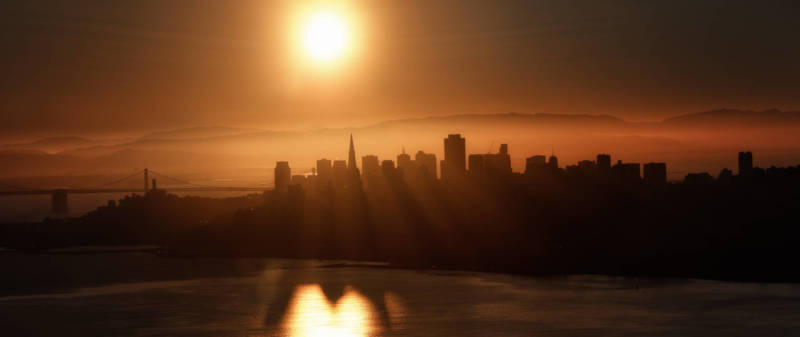The NWS says more of the same is in store for tomorrow, with a twist. Winds off the ocean -- onshore flow, in meteorological parlance -- moderated temperatures along the coast on Friday. Forecasters say that won't be the case tomorrow, and the excessive heat warning that's been in place for most of the region has been extended to the coast for Saturday.
Here's a rundown of what you might expect this weekend and how to deal with it:
How Hot, for How Long: The National Weather Service's San Francisco Bay Area forecast office in Monterey has issued an excessive heat warning that covers the entire region, except for areas adjacent to the Pacific Ocean. The warning -- which means "a prolonged period of dangerously hot temperatures will occur" -- will be in effect from 11 a.m. Friday through 9 p.m. Monday.
Bad Air: Most of us have noticed the hazy, crummy air quality the last couple of days -- or, if you're of a more lyrical bent, the coppery tinge to the evening and early morning light. The Bay Area Air Quality Management District says that's largely the result of wildfire smoke filtering into the region from blazes as far away as Oregon. The air district has issued a Spare the Air alert urging people to curtail driving and other activities that add to pollution.
The district's air-quality forecast shows unhealthy air for all groups in the Santa Clara and East Bay valleys and unhealthy for sensitive groups (those with respiratory illnesses, for instance) in the rest of the region.
Where It Will Be Hottest: The forecast for interior areas of most counties on Friday and Saturday includes highs reaching 116 in Walnut Creek, 115 in Pleasanton, 114 in Novato and 113 in Livermore. If that forecast pans out, some locations may exceed their highest recorded temperatures ever. Walnut Creek's all-time high, for instance, is 115 -- set on July 14, 1972. San Francisco's weekend high is forecast to be 90 on Saturday; Oakland is expected to hit 95 and San Jose 101 the same day.
The forecast prompted officials in Novato to declare a "minimum day" for students in the city's schools on Friday. Pupils in elementary schools will be sent home at noon, and high schools will let out at 12:45 p.m.
Where It Will Be Coolest: Most coastal areas will be warm -- with Pacifica and Half Moon Bay forecast to hit the mid-80s on Saturday -- but much, much cooler than inland regions. Most points along the coast in Sonoma and Marin counties are expected to remain in the 70s throughout the heat siege.
Staying Cool: The National Weather Service is emphasizing that the extreme heat on tap for most of the region poses a risk to everyone -- not just young children, older residents and other typically vulnerable groups. The National Weather Service's advice for coping with the torrid days to come:
- Limit strenuous outdoor activities, especially during the hottest time of day.
- Do not leave kids in vehicles.
- Stay in air-conditioned areas if possible.
- Drink plenty of fluids.
- Check on relatives and neighbors.
Contra Costa County, where heat is forecast to be particularly intense, offers an expanded list of steps to cope with high temperatures.
Cooling Centers: Here are lists of cooling centers publicized by county health authorities across the region:
Staying Safe at the Beach: The hot weather is likely to prompt many people to visit Bay Area beaches. The National Weather Service says it's particularly important to know that ocean waters are very cold -- between 54 and 56 degrees -- and that rip currents make many beaches extremely dangerous. Visitors should also be aware that many inviting areas, such as San Francisco's Ocean Beach, have no lifeguards.
Read more: the NWS surf zone forecast and tips for avoiding rip currents.
Hot Pets: Pet lovers are reminded to make sure their dogs and cats (or what have you) are protected from heat. Some basic advice during dangerously hot, sunny weather:
- Make sure pets have plenty of water.
- Never leave pets in cars.
- Be mindful of hot pavement, which can burn dogs' paws and cause a rapid increase in their body temperature.
- Know the signs of heat stroke in pets, which can include excessive panting, increased heart and respiratory rate, drooling, stupor or collapse.
Read more: ASPCA's Hot Weather Safety Tips
Power: The California Independent System Operator is forecasting record statewide power demand on Friday. On Thursday, the grid operator issued a flex alert -- a call for voluntary conservation -- through Friday night.
Transit Impacts: Both BART and Caltrain are slowing down because of the heat, a move that will cause delays on both systems. BART says it's reducing train speeds from the usual maximum of 80 mph in outdoor areas systemwide because of the possibility rails could shift in the extreme heat. The slowdown could increase travel times 10 to 20 minutes, BART says.
Caltrain informed passengers at midday Friday it was limiting trains to 60 mph.
